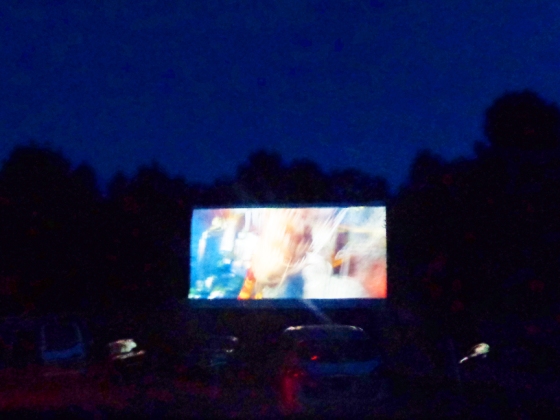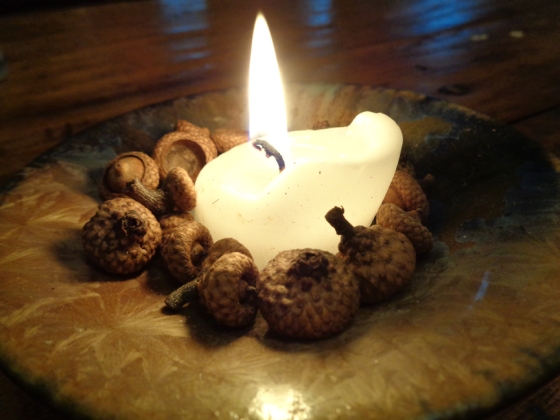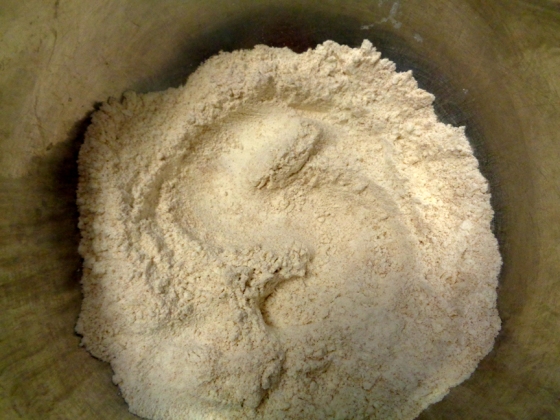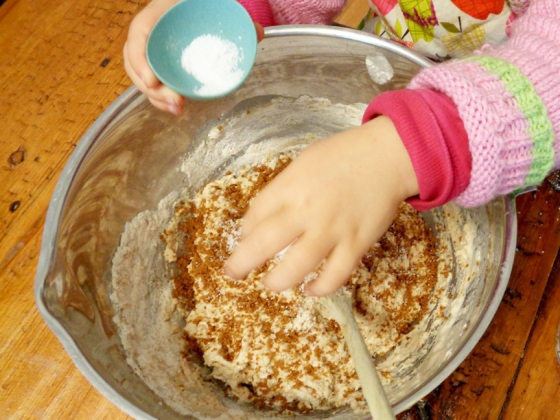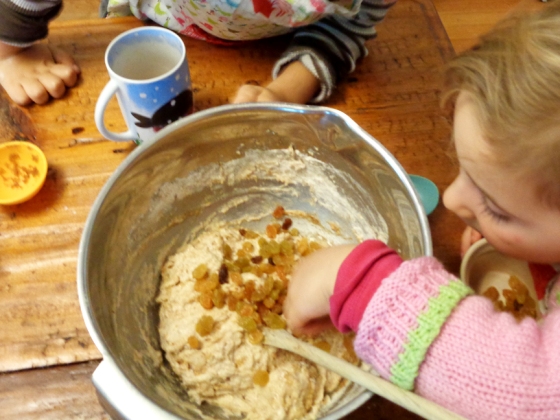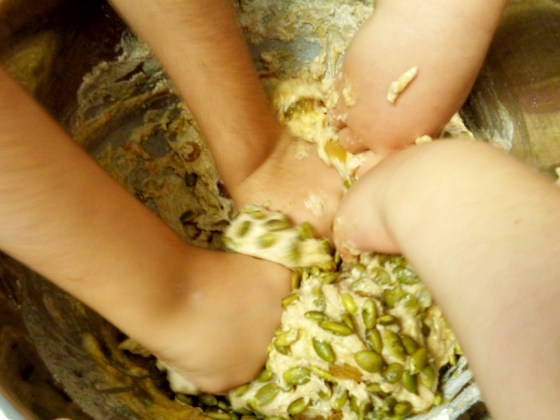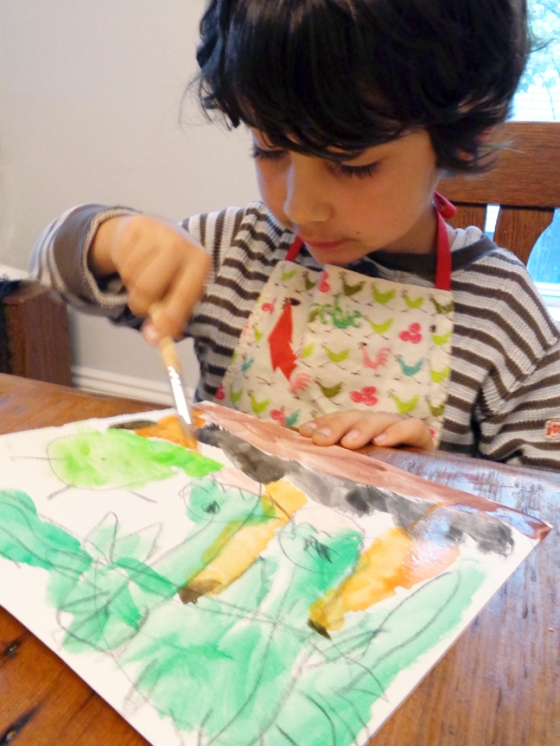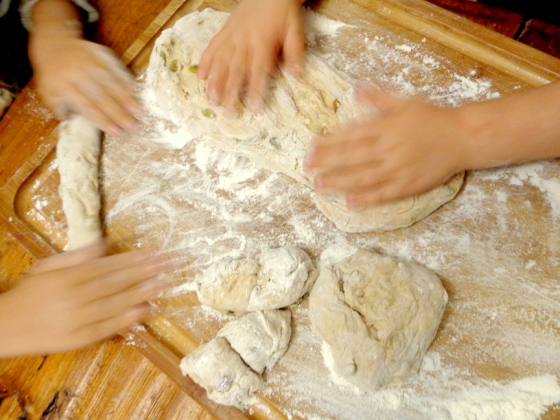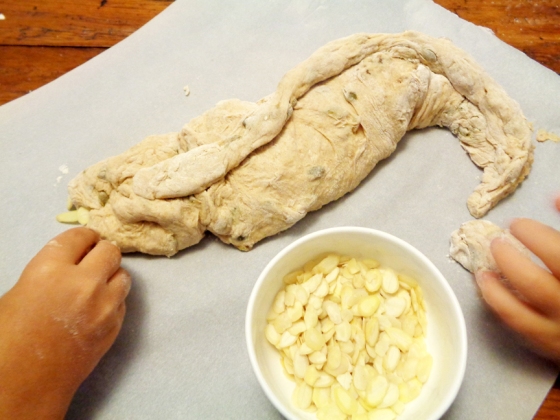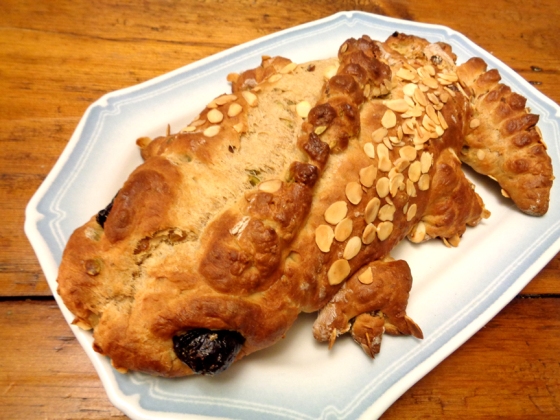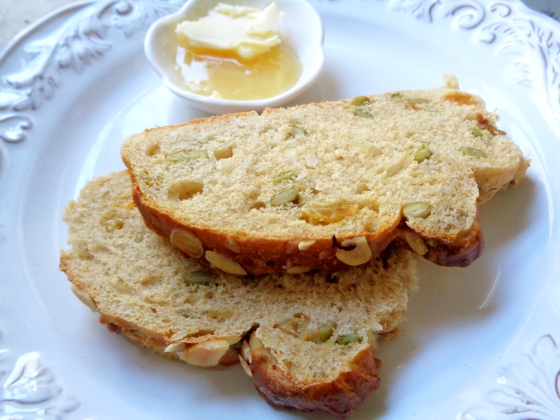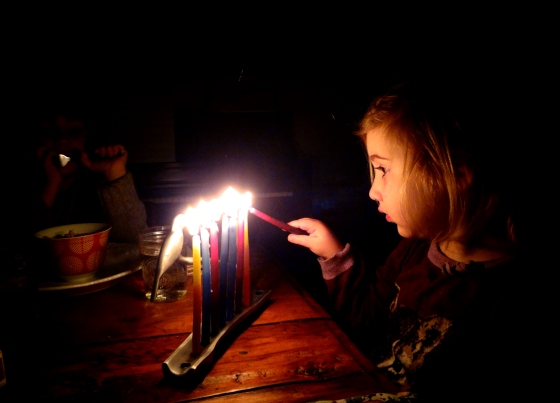 So yeah. I’m officially putting it right out there: I’m one of those bad Jews who celebrates Christmas. Like many children of interfaith marriages, I grew up celebrating both Hanukkah and Christmas. Though even before her marriage to my lapsed-Protestant dad, my (Jewish) mom’s side had already been putting up Christmas trees and welcoming Santa for generations, so if you are troubled by that you had best take it up with the 19th century Fishbeins who passed the tradition down to me and mine. If you want to know more about the history of Christmas-celebrating Jews, check out this fascinating piece from, of all places, The Jewish Daily Forward.
So yeah. I’m officially putting it right out there: I’m one of those bad Jews who celebrates Christmas. Like many children of interfaith marriages, I grew up celebrating both Hanukkah and Christmas. Though even before her marriage to my lapsed-Protestant dad, my (Jewish) mom’s side had already been putting up Christmas trees and welcoming Santa for generations, so if you are troubled by that you had best take it up with the 19th century Fishbeins who passed the tradition down to me and mine. If you want to know more about the history of Christmas-celebrating Jews, check out this fascinating piece from, of all places, The Jewish Daily Forward.
As lucky as I feel to have the joy of celebrating both these festive holidays, I do feel like Hanukkah, a relatively minor holiday in the Jewish religion, can feel a little lackluster under the shadow of the behemoth that is American Christmas, even if you don’t celebrate Christmas in your home. So over the years I’ve honed a few strategies for bringing out the excitement and beauty of this holiday for my family, with traditions that highlight the anticipation and nostalgia of celebrating Hanukkah, as well as foster a sense of connection with Jewish history, and let it stand alone as a bright light in the dark of December.
1) Start early. (And if you celebrate Christmas too, start that late).
As if I didn’t have enough winter celebrating to manage, I went and had a child on December 19. It seems like every pregnant woman I’ve known perseverates on one thing that is The Problem I Must Solve Before This Baby Comes. For some it’s researching, test driving, buying and returning and re-buying the perfect stroller, or going on a manic pixie dream nesting spree to create the perfect nursery. For me, it was figuring out how the heck I was going to make my daughter’s birthday ever feel special amid the hubbub of the crazy Hanukkristmas michegas we have going on over here. So one tradition we began was that we don’t put our Christmas tree up until the 20th. (Other December birthday tips: never use holiday wrapping paper for birthday presents, no combination birthday-holiday gifts, at least until the child is old enough to ask for something really freaking expensive, and do not be afraid of the outdoor birthday party! If I can do it in snowy Vermont with a 2 year old, so can you!)
Anyway, all that to say that waiting until later in the month to put up our Christmas tree has the added benefit of giving us a nice long time to focus on Hanukkah (uh, and also the whole, y’know, birthday thing). I get all our Hanukkah books out the day after Thanksgiving, (uh, except for last year when Hanukkah came so early we had to start reading Hanukkah stories as soon as Halloween was done!) Beginning to talk and read about Hanukkah and all the ways we celebrate it well in advance of the actual holiday help to build up a sense of excitement and anticipation for the holiday to begin. Thanks to the terrific PJ Library program, we have quite a collection of Hanukkah books! Here are some of my favorites:
 Grandma’s Latkes by Malka Drucker is a great picture book about a little girl making latkes with her grandma and talking about the story of Hanukkah. However you may want to edit it as you’re reading as it doesn’t shy away from the more gruesome parts of the story. (E.g., I leave out the part where Mattathias kills a poor Jewish guy who agrees to acquiesce to the Syrian soldiers’ demands.)
Grandma’s Latkes by Malka Drucker is a great picture book about a little girl making latkes with her grandma and talking about the story of Hanukkah. However you may want to edit it as you’re reading as it doesn’t shy away from the more gruesome parts of the story. (E.g., I leave out the part where Mattathias kills a poor Jewish guy who agrees to acquiesce to the Syrian soldiers’ demands.)
 Engineer Ari and the Hanukkah Mishap by Deborah Bodin Cohen also tells a lot of the Hanukkah story, with no gruesome details. It’s about a train engineer in Israel who has some mishaps on his way back home and ends up making friends with a Bedouin and celebrating Hanukkah with him in the desert. Bonus points for depiction of a peaceful Arab-Israeli friendship.
Engineer Ari and the Hanukkah Mishap by Deborah Bodin Cohen also tells a lot of the Hanukkah story, with no gruesome details. It’s about a train engineer in Israel who has some mishaps on his way back home and ends up making friends with a Bedouin and celebrating Hanukkah with him in the desert. Bonus points for depiction of a peaceful Arab-Israeli friendship.

Latkes and Applesauce by Fran Manushkin, now sadly out of print though still readily available from used booksellers, is the story of a poor Jewish family whose celebration of Hanukkah is derailed by a terrible snowstorm, which brings a forlorn kitten and dog to their door begging for shelter. The cat and dog end up helping the family find their own Hanukkah miracle.

Inside Out Grandma by Joan Rothenberg. I love this book because it gets right to the heart about what I love about holidays and traditions. Every time you celebrate, you are connected to all the past celebrations in your memories, and those of your parents and grandparents before you. The grandma in this story wears her clothes inside out to remind her of all the things about celebrating Hanukkah that will spark her memory to buy lots of oil for frying her potato latkes.

Hanukkah Bear by Eric Kimmel This story, first published in the stellar Cricket Magazine and then later as a picture book under the title “The Chanukkah* Guest” has the feeling of an old Jewish folk tale. It tells of Bubba Brayna, an elderly woman whose sight and hearing are not what the were, but who still makes the best latkes in her village, and her Hanukkah visitor, who is not, in fact, the rabbi she is expecting.
*A sign of the times – they changed the spelling likely due to the fact that in recent years Hanukkah has become the most popular spelling, ousting longtime favorite Chanukah. (Chanukkah with two K’s being much further down the list). I guess when Reform Judaism and the Library of Congress have adopted Hanukkah as their official spelling, you go with the tide.

Another great Eric Kimmel Hanukkah book is When Mindy Saved Hanukkah. If you’re a fan of The Borrowers, The Littles, or the obscure 1980s comic strip The Tweens at Deep Lake, you’ll love this tale of a tiny family living inside the walls of a synagogue, and their daring mission to bring home a Hanukkah candle. The illustrations, by Barbara McClintock, of Adele and Simon fame, are gorgeous and stunningly detailed.
 I can’t talk about Eric Kimmel without mentioning his Caldecott Award-winning masterpiece, Hershel and the Hanukkah Goblins. Another story originally published in Cricket, this book finds Jewish stock folk tale character Hershel of Ostropol outwitting a series of Goblins in order to end their suppression of Hanukkah celebrations in the village. While it has nothing to do with the tale of the Maccabees and the miracle of the oil, Herschel and the Hanukkah Goblins draws on the same themes of bravery against a mighty foe and carrying steadily on with Jewish practices in the face of oppression. Though the illustrations, by my beloved Trina Schart Hyman, might be a little scary for some preschoolers, my three year-old monster and dragon fan daughter adores them.
I can’t talk about Eric Kimmel without mentioning his Caldecott Award-winning masterpiece, Hershel and the Hanukkah Goblins. Another story originally published in Cricket, this book finds Jewish stock folk tale character Hershel of Ostropol outwitting a series of Goblins in order to end their suppression of Hanukkah celebrations in the village. While it has nothing to do with the tale of the Maccabees and the miracle of the oil, Herschel and the Hanukkah Goblins draws on the same themes of bravery against a mighty foe and carrying steadily on with Jewish practices in the face of oppression. Though the illustrations, by my beloved Trina Schart Hyman, might be a little scary for some preschoolers, my three year-old monster and dragon fan daughter adores them.
 I always love the sweet Jewish holiday books by Jane Breskin Zalben. Her book Pearl’s Eight Days of Chanukah is no exception. It’s a bit long for reading at one sitting, but it tells about Pearl and her family celebrating Hanukkah in different ways for each of the eight nights, and includes instructions and recipes for readers to try at home.
I always love the sweet Jewish holiday books by Jane Breskin Zalben. Her book Pearl’s Eight Days of Chanukah is no exception. It’s a bit long for reading at one sitting, but it tells about Pearl and her family celebrating Hanukkah in different ways for each of the eight nights, and includes instructions and recipes for readers to try at home.
Which brings me to my next Hanukkah tip:
2) Celebrate a different way each night. Beyond lighting candles, saying blessings, and opening a present, there are lots of different aspects of Hanukkah that you can highlight to bring a new excitement to each night. I actually got this idea from a PJ Library blog post a few years ago, and we have had great success with this idea ever since.
Some of the different themes we’ve enjoyed are:
Decorating Night. This a great one for the first day of Hanukkah, to get your house looking festive right off the bat. Spend the afternoon making some decorations and make sure to hang them up in time to light your menorah at sundown! Here are some decorating crafts I love:
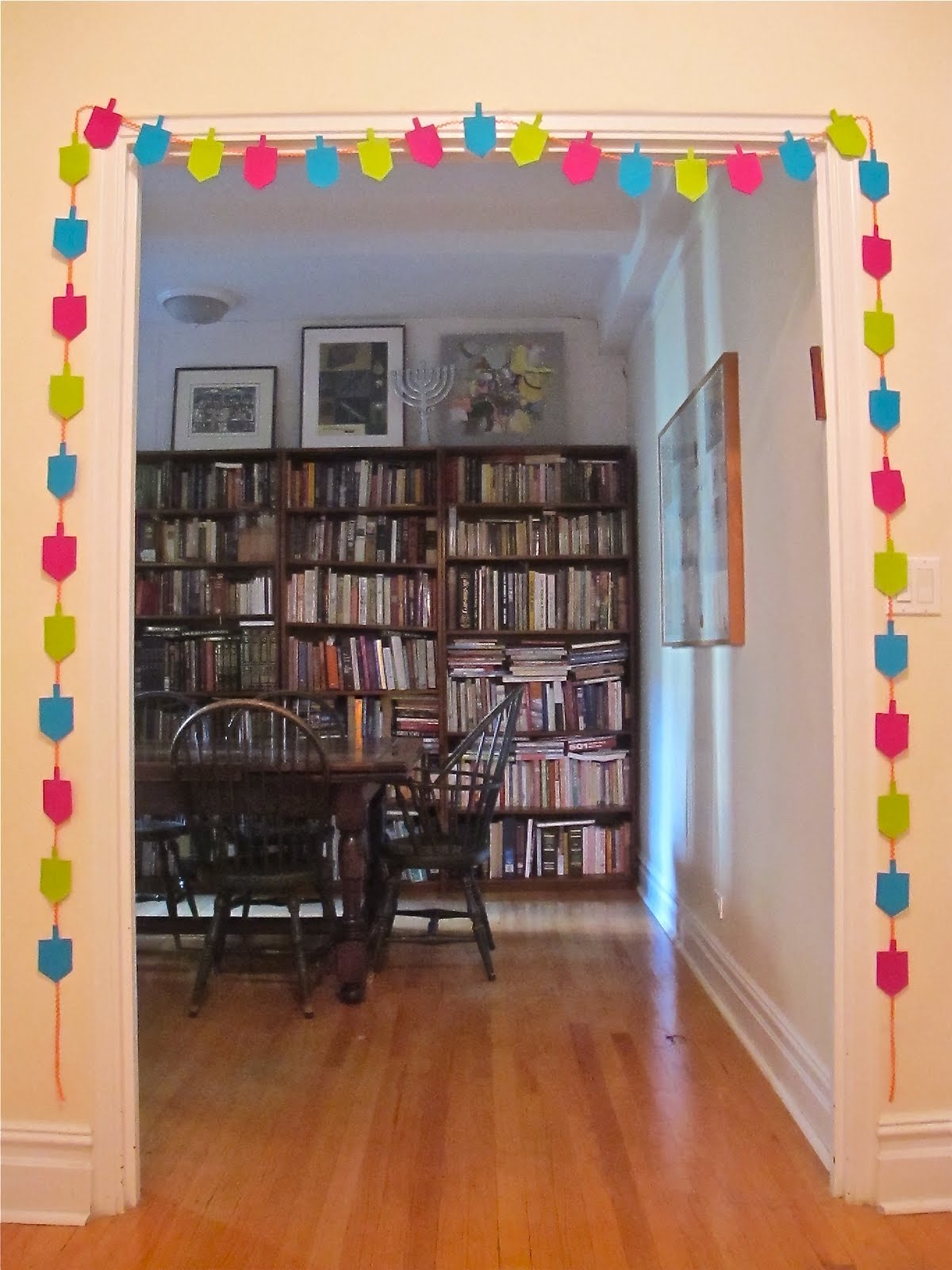 Dreidel garland. (We did an even simpler version than this, just cut out a bunch of dreidel shapes from some blue paint chips I had left over from our entryway painting project, and stitched them together with the sewing machine.)
Dreidel garland. (We did an even simpler version than this, just cut out a bunch of dreidel shapes from some blue paint chips I had left over from our entryway painting project, and stitched them together with the sewing machine.)
 Magen David window stars
Magen David window stars
 Sculptural Lego menorahs
Sculptural Lego menorahs
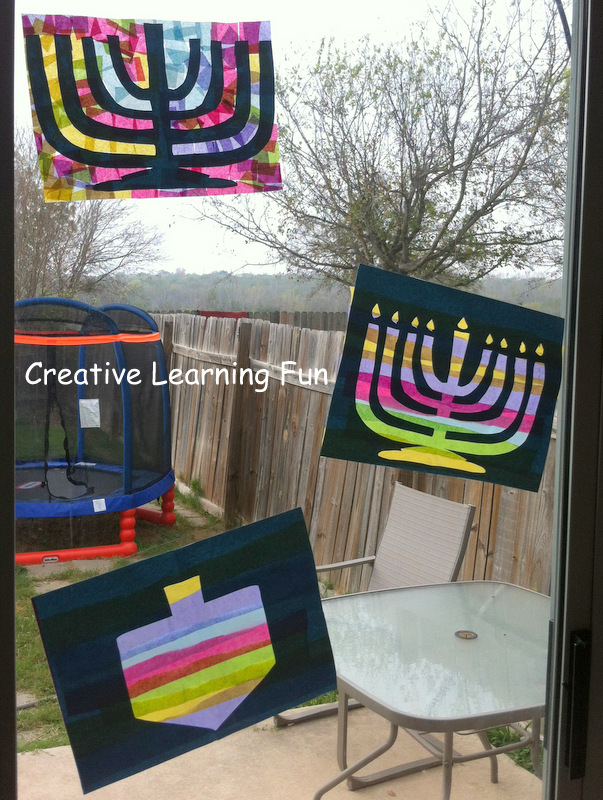 Hanukkah stained glass windows
Hanukkah stained glass windows
 And for the very littles, Handprint menorahs!
And for the very littles, Handprint menorahs!
Singing and Dancing Night
I start busting out my Hanukkah song repertoire around the same time as the books come out, right after Thanksgiving. By the first week of December, my kids are singing Oh Hanukkah, Oh Hanukkah in their sleep. I find that with kids and music, the more times they have heard a song, the more they enjoy it, so we sing songs ALL the time. But it’s still fun to set one night aside as a night for a Hanukkah dance party! Another fun way to celebrate music night is to sing Hanukkah songs for a friend or family member, whether in person or via skype. I guarantee there will be major kvelling.
Latke Night
This is probably my longest standing Hanukkah tradition, with the exception of candle-lighting. My cousin and I (and in later years, my boyfriend-then-husband and I) used to throw an annual Latke and Egg Nog bash and over time, my latke preparing method became this finely honed masterpiece of a recipe. No kidding guys, these latkes are fool-proof and superb. Savory, soft on the inside and crispy on the outside, even when reheated. And they smell like heaven when you’re cooking. My family is already getting excited for them and Hanukkah is still 8 days away!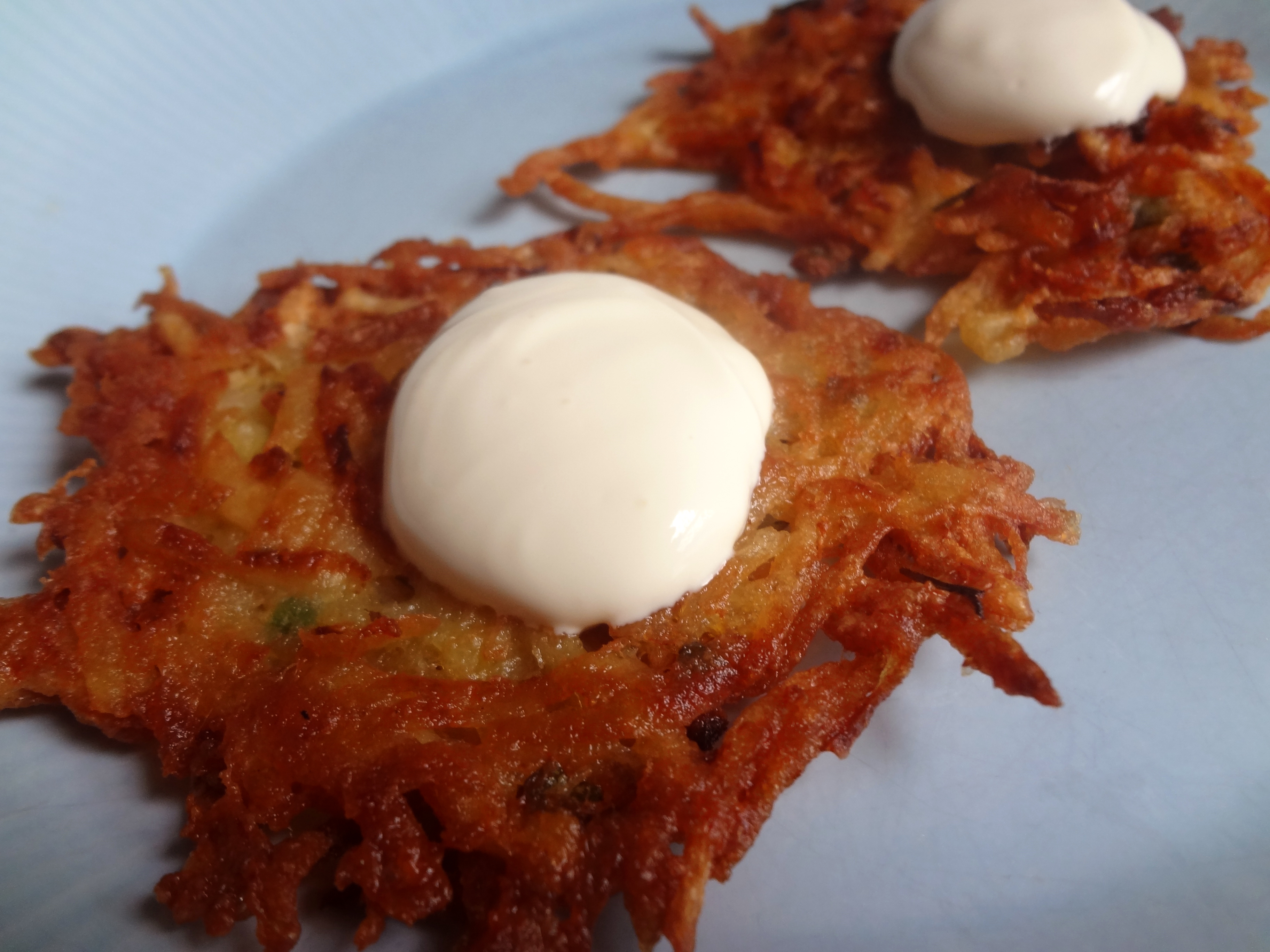 Now with the aforementioned December birthday in our family we don’t usually get around to hosting a holiday party, but I still maintain my habit of frying up about 8 dozen latkes near the beginning of Hanukkah, and my recipe reheats beautifully in the oven for subsequent nights or for bringing to a party that somebody else invites us to!
Now with the aforementioned December birthday in our family we don’t usually get around to hosting a holiday party, but I still maintain my habit of frying up about 8 dozen latkes near the beginning of Hanukkah, and my recipe reheats beautifully in the oven for subsequent nights or for bringing to a party that somebody else invites us to!
And if you like to make your own applesauce, this is my absolute favorite recipe: Roasted Applesauce a la Judy Rodgers of Zuni Cafe fame (home of that famous dry-brined chicken, which is extremely succulent and pairs quite well with a dinner of latkes and applesauce).
Community Night
Speaking of parties, whether it’s getting together with extended family, friends, or strangers, we always try to spend at least one night of Hanukkah doing something with a community of other Jewish families. If you live in a city, it’s usually not to hard to find a synagogue or JCC who is hosting some family-friendly Hanukkah events. In other places, like here in rural Vermont, it’s not quite as easy. We have been lucky enough to be incorporated into the small but festive network of southeast Vermont Jews and can usually count on somebody to organize a Hanukkah gathering. Maybe I’ll even have the energy to host one again myself one of these years!
If you’re not a party person, another way to celebrate with your community is to attend a Hanukkah concert, play or puppet show performance. We had a great time a couple years ago at the Yiddish Book Center seeing the Galloping Gryphons wonderful interactive performance of The Magic Dreidel and A Parakeet Named Dreidel, a musical based on a story by Isaac Bashevis Singer. My kids had such a good time singing along that two weeks later, on Christmas Eve, in fact, my daughter laid awake in bed singing, at the top of her lungs, “HOW MANY CANDLES IN OUR CHANUKIAH?” Score one for Hanukkah.
Mitzvah Night
I think that spending one of the nights of Hanukkah focused on helping others is a wonderful way to share the joy of the season and help foster a sense of empathy and generosity in kids. Whether it’s volunteering at a soup kitchen, making a donation to charity, or just spreading holiday cheer by visiting a nursing home or bringing some treats to your neighbors, doing mitzvot is a really fun and rewarding way to celebrate Hanukkah.
If you want to make your mitzvah night part of a larger movement, Massachussetts parents Robert and Rachel Glazer and Amy Finn started The Fifth Night Project a few years ago. This project focuses on making real the concept of tzedakah (charitable giving) to preschoolers. Instead of receiving presents, kids go to a store and buy a present for someone in need. Other cities across the US have joined in and host annual gatherings to make these gift donations as a group, making it more concrete for kids just how their gift is going to help others.
Even if there is no Fifth Night event in your city, I absolutely love the idea of creating a nationwide tradition to spend this night of Hanukkah giving to others.
Dreidel Night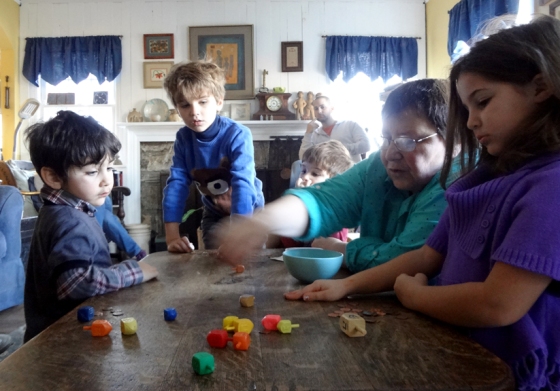 Nothing like a good old fashioned dreidel tournament to get the blood pumping! We have a penny jar that we use for gelt, but other fun things to play with are buttons, poker chips, or if you don’t mind the victors eating their spoils, nuts, raisins, m&ms, or of course chocolate gelt. At 6 and nearly 4, my kids have mastered both the rules of the game and the motor skills of a good dreidel spin. If you need a reminder on what the letters mean and how to play, here ya go.
Nothing like a good old fashioned dreidel tournament to get the blood pumping! We have a penny jar that we use for gelt, but other fun things to play with are buttons, poker chips, or if you don’t mind the victors eating their spoils, nuts, raisins, m&ms, or of course chocolate gelt. At 6 and nearly 4, my kids have mastered both the rules of the game and the motor skills of a good dreidel spin. If you need a reminder on what the letters mean and how to play, here ya go.
Sweets Night
So I don’t know what brought the Israeli obsession with sufganiyot to America in recent years, but any tradition that involves eating a lot of donuts is one I can get behind. (Despite the fact that sufganiyot are like the Elf on the Shelf of Hanukkah – the Israeli Labor Federation popularized them in the 1920s as an alternative to latkes, knowing that many home cooks shy away from deep-frying, thereby creating jobs and income for Federation bakers.) And actually, they are not that hard to make at home. Two Lazy Gourmets has this easy sufganiyot recipe that is as tasty as it sounds. And if you’re not up for celebrating the miracle of the oil by deep frying dough, you can always satisfy your holiday sweet tooth with some sugar cookies, Hanukkah brownies, or chocolate apricot gelt.
And if you’re not up for celebrating the miracle of the oil by deep frying dough, you can always satisfy your holiday sweet tooth with some sugar cookies, Hanukkah brownies, or chocolate apricot gelt.
Memory Night

I think taking a night to think and talk about favorite holiday memories is such a sweet way to spend the final night of Hanukkah. PJ Library even suggests making a couple of scrapbook or journal pages about favorite Hanukkah memories, and adding to that each year. Reinforcing what you have loved about the holiday is a great way to give it some sticking power, especially when, like this year, the end of Hanukkah is succeeded immediately by the excitement of Christmas Eve.
3) Don’t make it all about the presents.
It’s really hard, even for families celebrating just Hanukkah, not to feel they have to compete with Christmas on the present front. Heck, it’s hard for Christmas not to compete with Christmas(TM) on the present front! The whole tradition of giving Hanukkah gifts was, in fact, created specifically to bolster Hanukkah’s luster as the American Christmas began to take on epic proportions at the turn of the 20th century.
Deciding how much is too much is a very personal decision for each family. We choose not to give our kids any presents for Hanukkah, (and for that matter, only a few items for Christmas). We are lucky to have very generous relatives on my husband’s side who give presents on Hanukkah, and when we celebrate all together, seeing the kids joyfully opening their Hanukkah gifts is indeed one of the happiest moments of the holiday. However, I really enjoy that all our other nights of Hanukkah are spent really celebrating and relishing all the other wonderful aspects of the holiday, and not just rushing through to the presents. Not to seem like a total sanctimonious simplicity grinch, but I find that having a very limited amount of presents helps our children fully appreciate and enjoy the gifts they do receive.
When we first became parents, my husband especially was concerned that Hanukkah be something really special for our kids and not just a warm-up for Christmas, so he was a little skeptical about my idea of not buying them any presents. But six Hanukkahs later, he is fully on board with our festive, musical, delicious, fun-filled, and low-on-presents way of celebrating. I think one of his most vindicating moments may have been one year when we were staying in a hotel room in Baltimore, visiting family for Hanukkah, and watching the ending of White Christmas on the TV. Our then two year-old daughter saw the little elf dancers twirling and spinning around and yelled, “SEVIVON, SOV, SOV, SOV!” (For those of you keeping score at home, that’s Hanukkah 2, Christmas 0.)

Another one of our favorite Hanukkah picture books is the lovely holiday story Light the Lights. It follows a little girl through the holiday season as her interfaith family celebrates first Hanukkah and then Christmas. It ends with the line “…she remembered the bright winter lights in the dark winter nights for a long, long time.” The glory of Christmas notwithstanding, I hope that our traditions let Hanukkah shine on as a moment of warmth and light in the darkest days of winter, connecting us to our family, our community, and our ancestors.
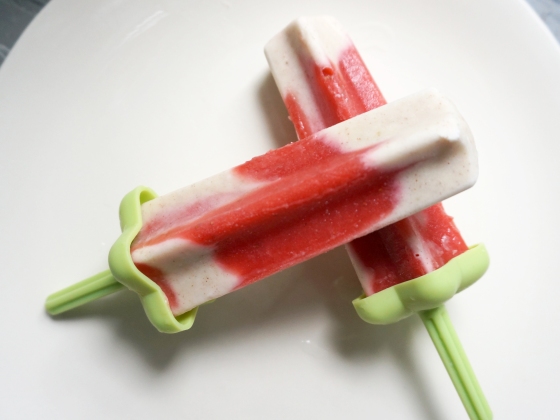 You guys! It’s popsicle season again! We are pounding through the pops over here and my latest concoction is the best one yet. It’s based on the superb rhubarb curd bars with spiced shortbread that I posted about last June, but way simpler. Just a simple strawberry-rhubarb jam swirled together with some yogurt spiked with maple, cinnamon, cloves, and cardamom. So sweet, tart, and refreshing, with a subtle zing of eastern spice. I shall now eat these continuously until the rest of the berries are in season. (So, about 2 more months). Enjoy!
You guys! It’s popsicle season again! We are pounding through the pops over here and my latest concoction is the best one yet. It’s based on the superb rhubarb curd bars with spiced shortbread that I posted about last June, but way simpler. Just a simple strawberry-rhubarb jam swirled together with some yogurt spiked with maple, cinnamon, cloves, and cardamom. So sweet, tart, and refreshing, with a subtle zing of eastern spice. I shall now eat these continuously until the rest of the berries are in season. (So, about 2 more months). Enjoy!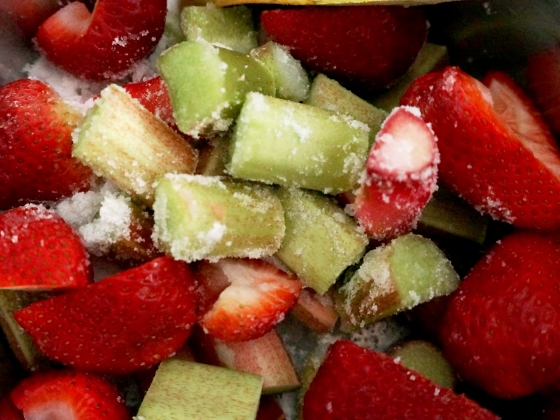
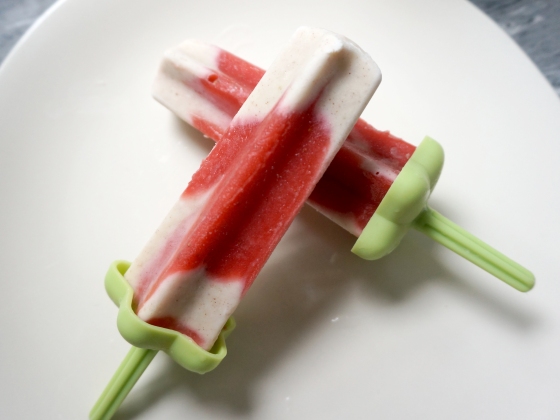
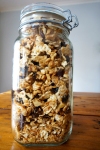
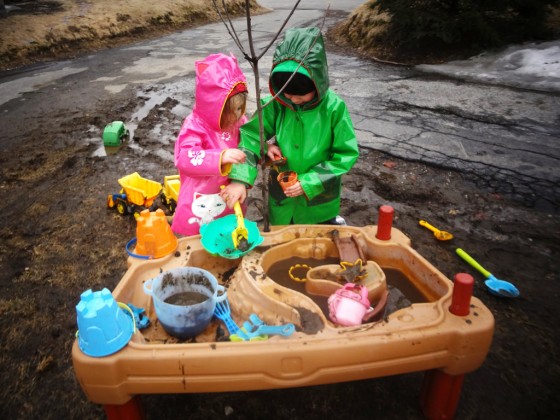
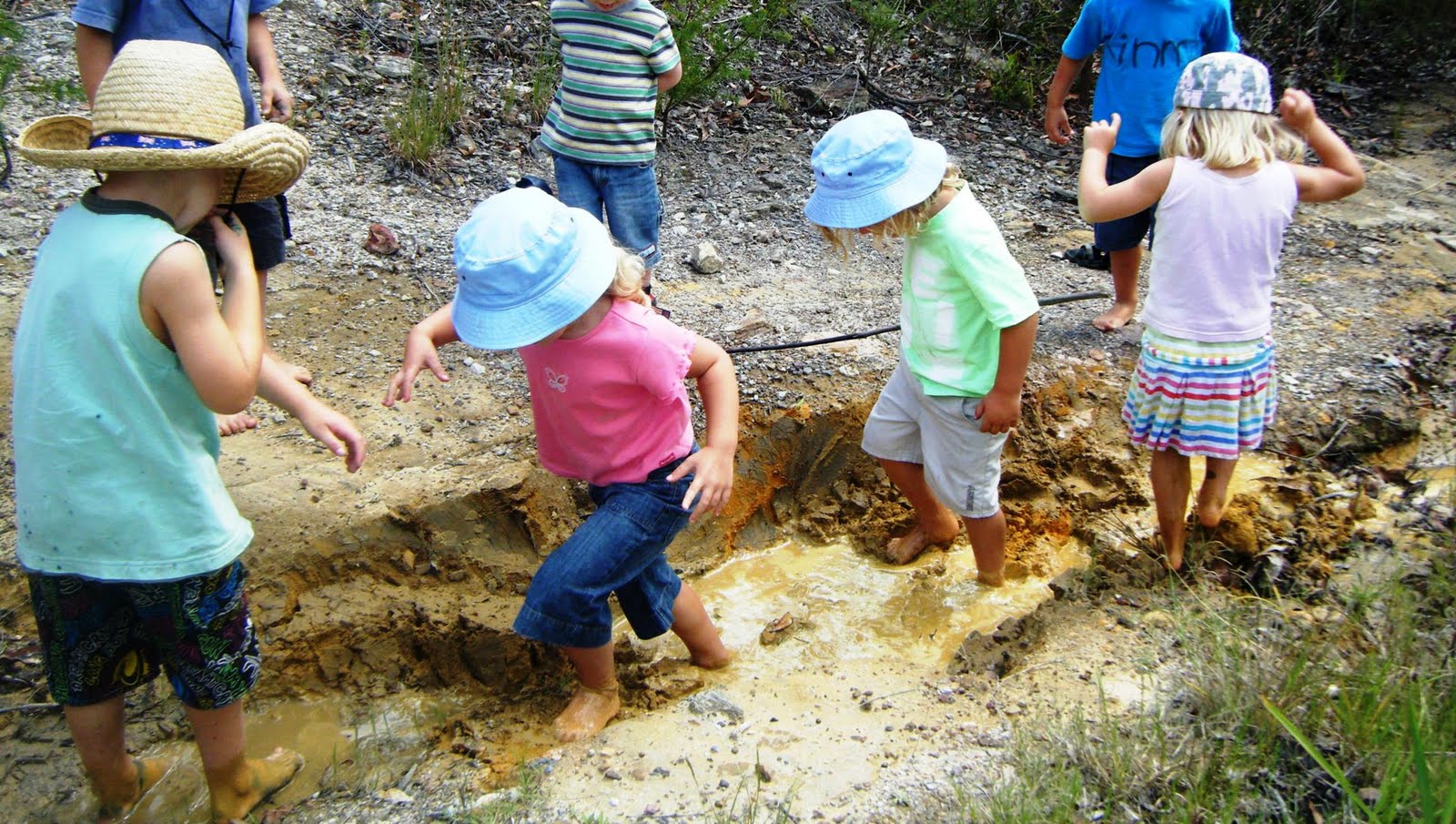




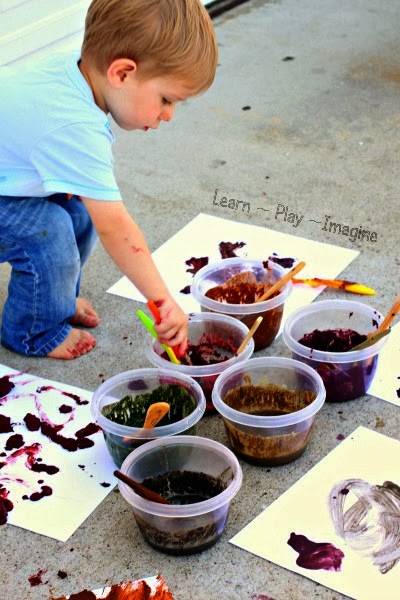
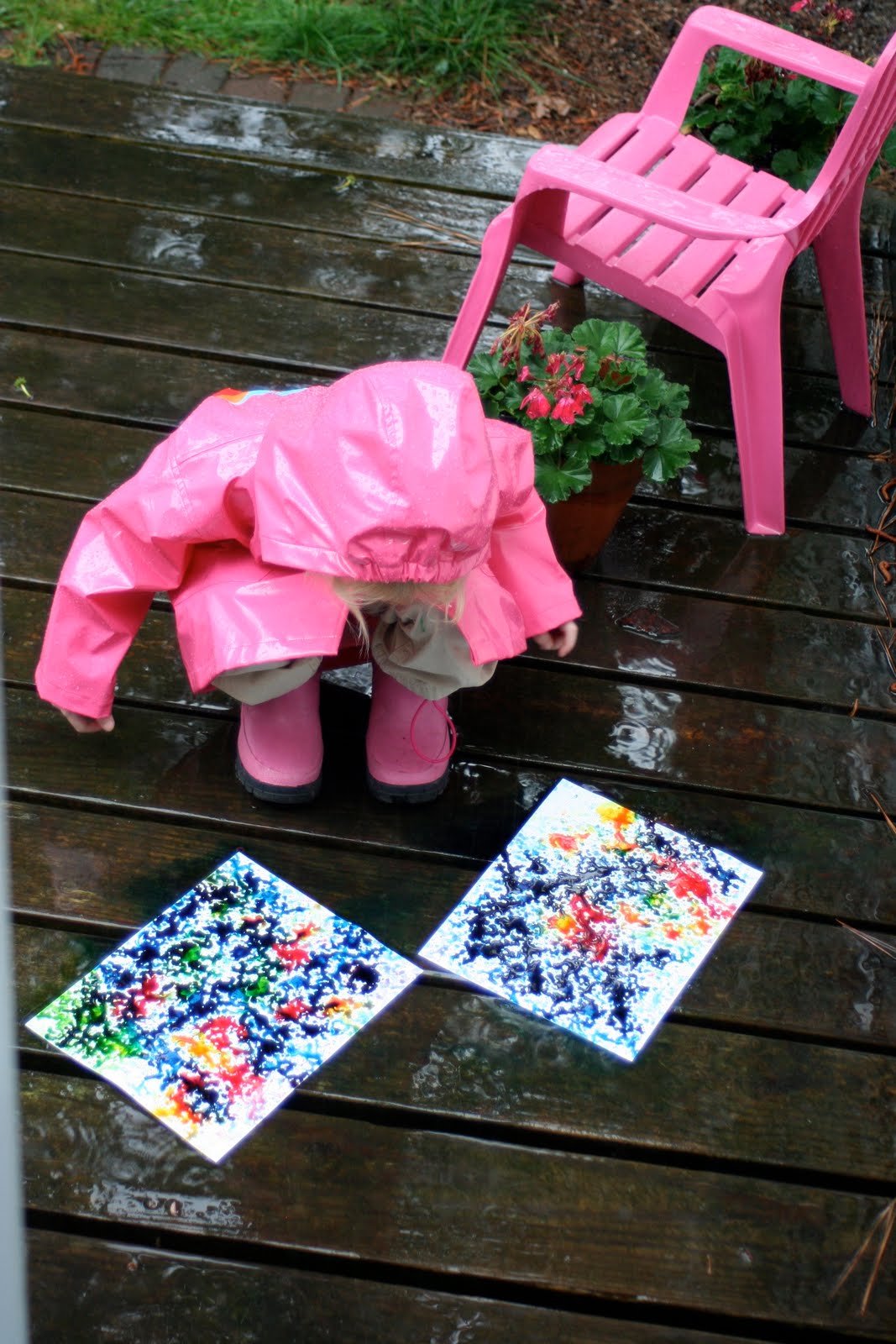
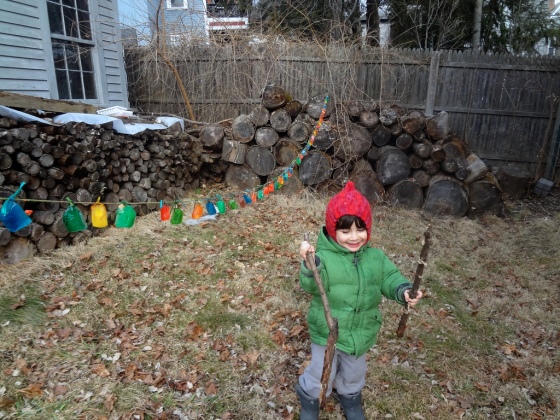

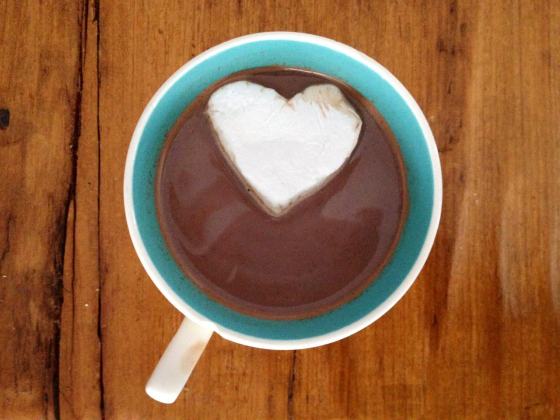
 I saw these the other day on
I saw these the other day on 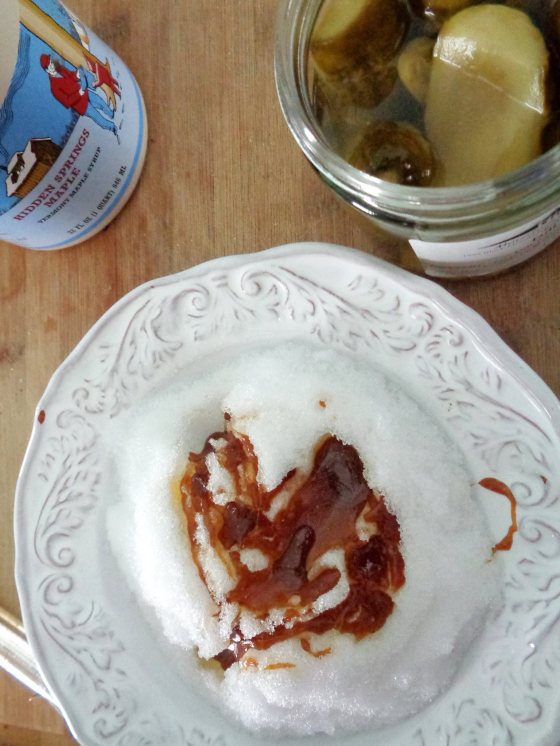

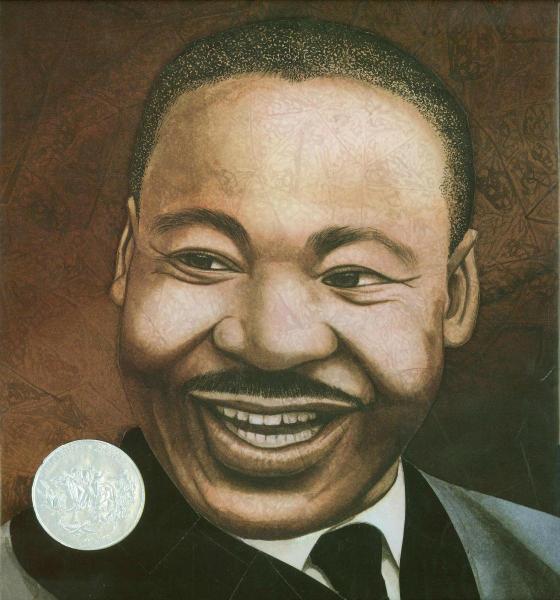
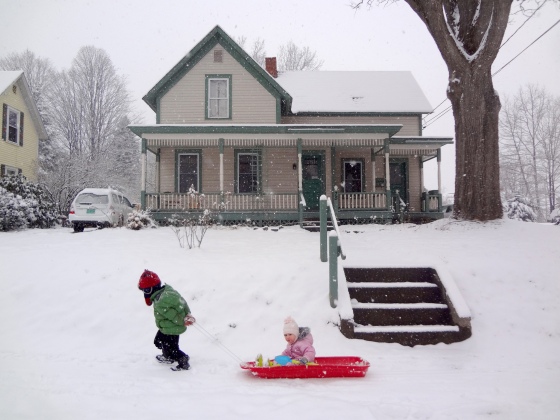

 Grandma’s Latkes
Grandma’s Latkes




 I can’t talk about Eric Kimmel without mentioning his Caldecott Award-winning masterpiece,
I can’t talk about Eric Kimmel without mentioning his Caldecott Award-winning masterpiece,  I always love the sweet Jewish holiday books by Jane Breskin Zalben. Her book
I always love the sweet Jewish holiday books by Jane Breskin Zalben. Her book 

 Sculptural Lego menorahs
Sculptural Lego menorahs
 And for the very littles,
And for the very littles,  Now with the aforementioned December birthday in our family we don’t usually get around to hosting a holiday party, but I still maintain my habit of frying up about 8 dozen latkes near the beginning of Hanukkah, and my recipe reheats beautifully in the oven for subsequent nights or for bringing to a party that somebody else invites us to!
Now with the aforementioned December birthday in our family we don’t usually get around to hosting a holiday party, but I still maintain my habit of frying up about 8 dozen latkes near the beginning of Hanukkah, and my recipe reheats beautifully in the oven for subsequent nights or for bringing to a party that somebody else invites us to!
 And if you’re not up for celebrating the miracle of the oil by deep frying dough, you can always satisfy your holiday sweet tooth with some
And if you’re not up for celebrating the miracle of the oil by deep frying dough, you can always satisfy your holiday sweet tooth with some 

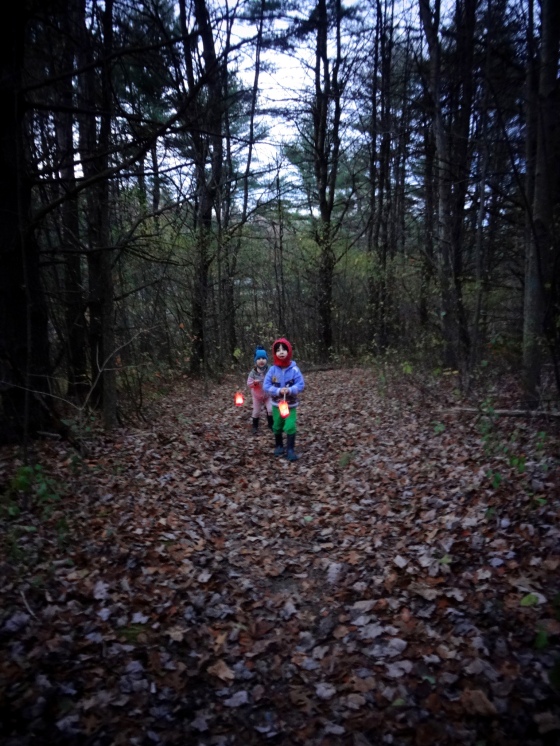 One of my favorite fall traditions is the
One of my favorite fall traditions is the 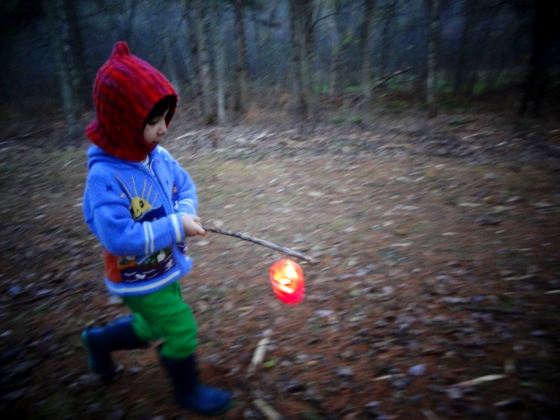
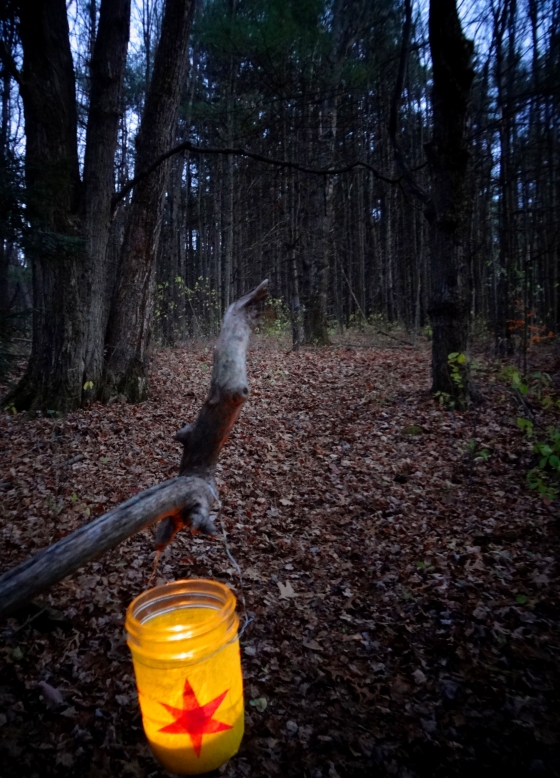 The first time we were planning to go on a lantern walk, an hour beforehand, my son fell off the couch and broke his arm. PSA: apparently, sitting quietly listening to audiobooks can be hazardous to your health. So we made our own lantern walk a week later with a short tramp around our neighborhood, singing
The first time we were planning to go on a lantern walk, an hour beforehand, my son fell off the couch and broke his arm. PSA: apparently, sitting quietly listening to audiobooks can be hazardous to your health. So we made our own lantern walk a week later with a short tramp around our neighborhood, singing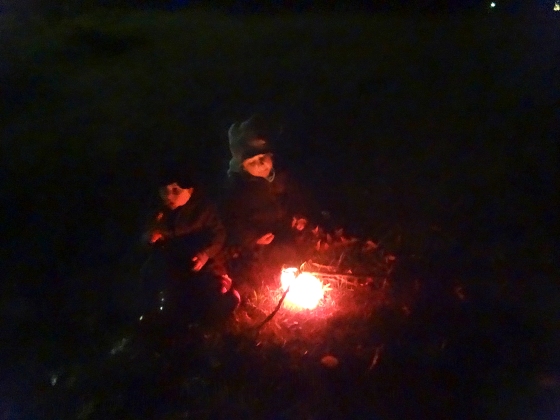
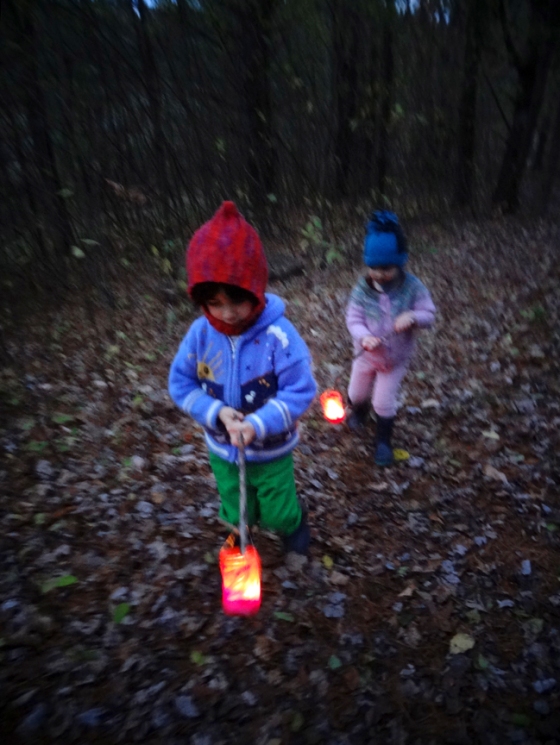
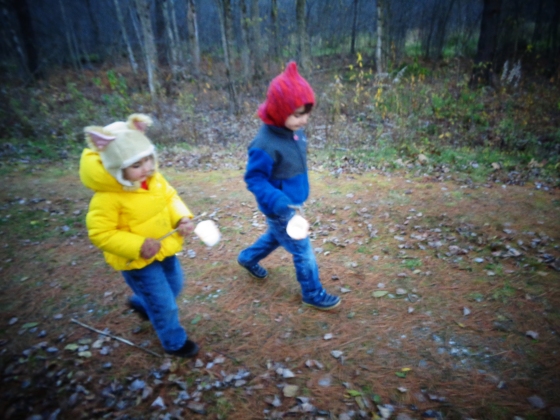 When we stopped for our modest snack of cinnamon toast, grapes, and warm
When we stopped for our modest snack of cinnamon toast, grapes, and warm 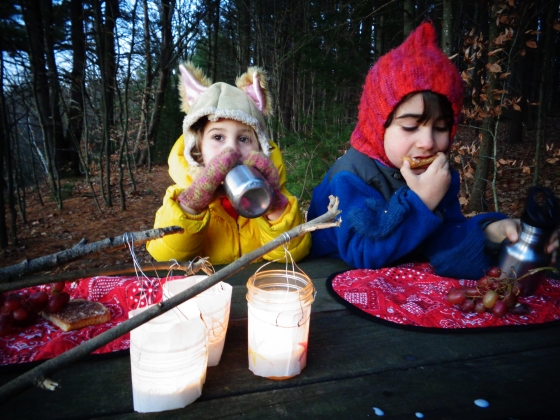 As we made our way back along the trail, we cheerily sung our lantern songs, making sure any nocturnal animals in the vicinity would give us a wide berth. We arrived peacefully back at the trailhead with nary a stumble over a tree root, though my daughter was heartily disappointed that at the end of our walk there were no neighbors to sing to like in the story. Looks like we’ll have to plan a cookie-and-caroling walk next!
As we made our way back along the trail, we cheerily sung our lantern songs, making sure any nocturnal animals in the vicinity would give us a wide berth. We arrived peacefully back at the trailhead with nary a stumble over a tree root, though my daughter was heartily disappointed that at the end of our walk there were no neighbors to sing to like in the story. Looks like we’ll have to plan a cookie-and-caroling walk next!